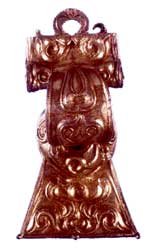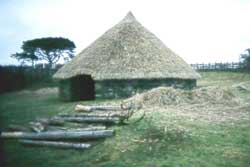Sources

Click on the image for a larger version.
|
Image
details:
The Aesica Brooch. The form and swirling
scroll decoration derive from pre-Roman 'Celtic' metalwork.
The 10cm high gilded bronze brooch would probably have been
worn as one of a pair at the shoulders, linked by a chain
through the loop.
Image ownership:
© The Museum of Antiquities of the University and
Society of Antiquaries of Newcastle upon Tyne |
The native population is the silent companion of the Roman army
on the frontier. During the conquest they are glimpsed in the Roman
historians, resisting or submitting to Roman power. Speeches put
in the mouths of Britons by Roman historians tell us only about
Roman attitudes to conquest and empire. Representations of Britons
on monuments produced by the Roman army include striking images
of submission or extermination, but these follow general conventions
for portraying barbarians and are not a safe guide to the appearance
of the Britons. Concerning the Britons the Vindolanda tablets have
little to say, save for a dismissive reference to Brittunculi,
‘wretched little Britons’, in an enigmatic note referring
to their fighting abilities (164).
The archaeological evidence for the native population is however
a rich resource, although it has received less attention than the
remains left by Roman occupation. Beyond doubt is the long history
of human settlement in the frontier area before. Roman power did
not encounter a tabula rasa, but diverse and well-established
societies.
Political and social organisation
Much of northern Britain, from the river Trent to southern Scotland
was occupied by a large tribal confederation, the Brigantes. This
was made up of many smaller tribes, some of whose names are recorded
in texts and inscriptions. One such subgroup were the Textoverdi,
whose curia ('tribal centre' or 'assembly place'), is recorded
on an altar dedicated to the deity Sattada found at Beltingham,
a village two miles from Vindolanda. The altar may have been brought
there from Vindolanda in the post-Roman period.
Settlements

Click on the image for a larger version.
|
Image
details:
A reconstruction of a round house, based
on an excavated site near Otterburn, Northumberland. It has
been built in the Brigantium Archaeological Reconstruction
Centre
Image ownership:
© Dr. Clive Waddington |
Most people probably lived in the many individual farmsteads of
the type that have been found across Cumbria, Northumberland and
county Durham. These take the form of enclosures containing one
or more buildings often set within well-preserved field systems.
The roundhouse is the typical building type, continuing the architectural
style of the prehistoric period found across Britain. Pollen sequences
from bogs and meres suggest that by the arrival of the Romans much
of the frontier zone landscape had been open and farmed for centuries.
In the Roman period the expressions of Roman culture typical of
southern Britain only developed on the southern margins of the Brigantian
area, including towns, for example Isurium
and villas, of which a few are scattered across North Yorkshire.
In the frontier zone towns such as Corbridge and Carlisle provided
some of the urban attractions available to southern Britons: the
smaller vici attached to forts perhaps
played some role as local centres.
The demands of Rome
The army is likely to have required food and raw materials from
the population of the frontier zone, through tribute and taxation
in coin and in kind and sale through the army. Population and agricultural
production perhaps increased, under the stimulus of peace and the
demands of the military market, especially in the agriculturally
richer areas such as the Solway plain. However if food was supplied
to the military, this has left little archaeological trace. Excavations
of farmsteads normally recover few of the artefacts that long distance
supplies brought to the military sites nearby, such as pottery from
Gaul or amphorae. Roman coins are also rarely found. Unlike southern
Britain, rural dwellers did not adopt Roman style architecture.
Items produced by the native population are equally rare on Roman
sites, some styles of brooch and horse gear being among the few
instances. The Aesica brooch, probably made in northern England
around AD 70-80 and found at Great Chesters fort (Aesica)
on Hadrian's Wall is one of the most striking examples of such metalwork.
Contact between the military and local communities must have been
close, but what form did it take to leave such little trace?
The Roman state is also likely to have demanded manpower.
Natives perhaps worked on behalf of the army, perhaps moving supplies
or materials. Like all the regions absorbed into the empire, Britain
contributed auxiliary units to the army. Most British auxiliary
units were posted to Rome's continental frontiers. They are first
mentioned in inscriptions in the mid second century on the German
frontier, but recruitment probably began earlier. Once units were
based on Hadrian's Wall over the long term, the possibility of joining
the frontier garrison also offered Britons an alternative to a life
of farming and an opportunity of enrichment and prestige.
|